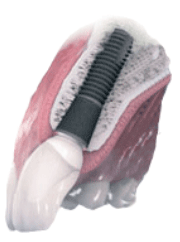Implants

Crowns and conventional bridges or dentures may not be your only options when replacing missing teeth. For some people, dental implants offer a smile that looks and feels very natural. Surgically placed below the gums implants fuse to the jaw bone and serve as a base for individual replacement teeth, bridges or a denture.
What are Dental Implants?
Dental implants are metal anchors placed in the jaw bone underneath the gum tissue to support artificial teeth where natural teeth are missing. Unlike other types of tooth replacements, dental implants are actually placed into the jaw bone under the gum tissue and are not cemented to remaining teeth. These implants are usually made from space-aged metal called titanium, which is readily accepted by the body. Accepted by the ADA, dental implants have been used for many years, and hundreds of thousands have been placed. Due to a phenomenon know as "osteointegration" (the bone actually attaches itself to the implant), these anchors provide a strong foundation that allow people with missing teeth to chew efficiently and comfortably.
https://www.youtube.com/watch?v=HZHS2miPqAk&list=PLGgI6DU1urWm1Bcy3yv0RAYCdOYhhFrZV-
The best type of implant
is an endosteal implant, which is similar in shape to the root of the natural tooth. These implants serve as a replacement for the roots of missing teeth and are placed directly into the jaw bone. This process actually integrates the jaw bone into the implant during the healing phase, producing a very strong foundation.
Implant Surgery
The placement of endosteal dental implant requires two different surgical procedures. First, the implants or "fixtures", are placed in the bone. In the second surgery, which takes place after osteointegration is complete, the submerged implants are solidly anchored in the bone, the fixtures are uncovered and special posts (abutments) are attached to the implants. These abutments project above the gum line into the mouth, and the final restoration fits onto them.
Making your new teeth
When your gum tissues have completely healed after the second surgery, you are ready to begin fabrication of your new prosthesis. We will make impressions of your mouth, and bite registrations that record the way your jaws fit together, then the impressions are used to make models of your jaws and any remaining teeth. Your restorations will be made based on these models. Your teeth ("restorations" or "prosthesis") will be either removable, fixed, or a combination of both. A removable prosthesis is similar to a conventional denture but it is very stable. A fixed prosthesis can replace one tooth, several teeth, or even all your teeth. The restorations are screwed into the abutments or cemented onto them, and held firmly in place.
Candidates for dental implants need to have healthy gums and adequate bone to support the implant. To maintain the implants, patients must be in overall good health and committed to keeping their new smile healthy .A thorough evaluation will help determine whether you are a good candidate for dental implants. Ask us whether implants are an option for restoring your smile.
